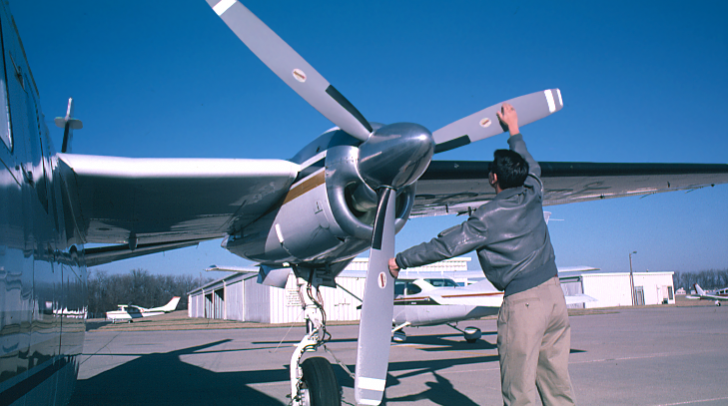By Rob Erlick

With the arrival of another summer, Indicated Outside Air Temperatures (IOAT) approach the +35 °C (+95 °F) range, and a number of operational factors as they relate to TPE331 engine operations should be considered.
First, during the summer residual turbine temperatures remain at higher values for longer periods of time after engine shutdown. Because post-shutdown turbine temperatures have shown to have a significant impact on the rate of fuel nozzle plugging, often referred to as “coking” (coking or baking-on a varnish type of coating) inside the fuel nozzle passages, the use of specific procedures to control these temperatures becomes very important.
In fact, the relationship between peak temperature (heat soak-back after engine shutdown) and coking rates is exponential. This implies that even a small reduction in peak temperature substantially reduces the rate of coking.
Two simple and common techniques involve the three-minute cool-down at low RPM before engine shutdown, and the rotation of the engines by hand within approximately five minutes after engine shutdown. By adhering to both suggestions, the high point of the peak soak-back temperature can be reduced.
The practice of rotating the propeller by hand also is commonly used to reduce the residual turbine temperature for subsequent starts on quick turnarounds. How many propeller blades the engine should be turned through, and how vigorously it is turned, is up to the operator. However, in general, three to four propeller revolutions (always in the designed direction of engine rotation), rotated briskly, is adequate.
In case a high residual-temperature engine start is unavoidable, Honeywell suggests to first motor the engine (delaying fuel and ignition) until the turbine temperature is less than 200 °C EGT or 300 °C ITT (as applicable) or until 15 % RPM, whichever occurs first.

Second, during ground operations in high IOAT conditions, engine oil temperature may creep into the high green range. Ambient factors such as wind direction and velocity contribute to the overall effect. Especially when the aircraft is static, such as during prolonged departure delays, the oil temperature may increase slightly above normal. The radiator-type oil cooler is designed to regulate oil temperature. If the oil cooler proves insufficient, slightly advancing the power levers facilitates oil cooling in two additional ways:
1. The advanced power lever angle commands an increase in engine RPM, which enhances cooler efficiency.
2. In Beta-mode of operation, the advanced power lever angle increases the propeller blade angle, thereby moving a greater volume of air across the engine nacelle and through the oil cooler radiator, which contributes to further oil cooling.
(NOTE: Hot oil slightly lowers the effective governing speed, while cold oil increases it. As a rule of thumb, an oil temperature 20 °C higher than normal equates to approximately one-half percent RPM loss on some TPE331-powered aircraft.)
The slightly increased engine RPM and the propeller-induced airflow offer several additional advantages. If the aircraft utilizes cooling turbine air conditioning, the elevated RPM increases the volume of bleed air available to the cooling turbine. This enhances environmental system performance and keeps the cabin and flight deck cooler. Also, the increased airflow across the engine nacelle reduces exhaust gas re-ingestion by the engine, which can cause incorrect inlet temperature sensing and tends to introduce a strong exhaust odor into the cabin air supply. In most instances the increase in RPM is barely noticeable to passengers.
Please bear in mind that when using increased RPM for ground cooling, professional airmanship would suggest consideration of the possible effect of increased propeller wake on other aircraft, personnel, or structures.
In conclusion, be cognizant of how high ambient temperatures affect engine operations and reliability. A few techniques can assist in efficient and more trouble-free engine operations. However, this brief article deals only with a few high-temperature-related engine issues. Therefore, the airplane operator is advised to review all implications, AFM/POM procedures, and other training manual suggestions associated with hot weather operations.
Please remember, the above tips are intended to be supplemental to the published operating procedures. For a complete study on aircraft operations in hot weather conditions, please refer to the procedures and recommendations published in the FAA/CAA approved AFM and POM for the appropriate make and model. As always, pilots can make the difference in engine operating life and maintenance costs.
The information in this article is provided to aid in the proper and efficient operation of TPE331 engines as it relates to hot/summer operations. However, as always, procedures outlined in the applicable FAA-approved Airplane Flight Manual (AFM) take precedence over those tips outlined in this article. For additional questions on the above subject or any other TPE331 engine-related issues, please don’t hesitate to contact Honeywell’s Flight Technical Services (FTS) by calling (480) 399-4007 or e-mail Robert.Erlick@Honeywell.com
